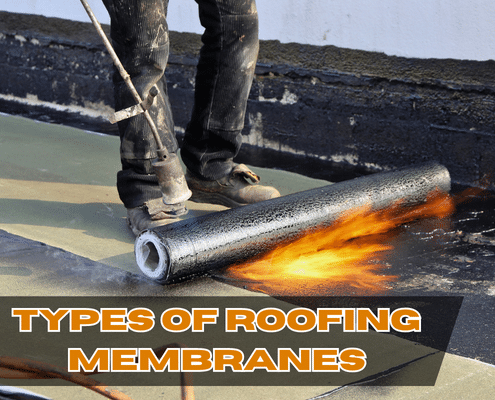4.9 1890+ Google Reviews

Low sloped roofs need different materials than steep roofs. For example, asphalt shingles on a low-sloped roof will leak. So, let's dive into single-ply roofing membranes that won't leak.
Modified bitumen (mod bit) consists of asphalt and rubber or plastic. However, unlike asphalt shingles, you can install them on flat roofs. Like the other single-ply membranes on this list, it is sold in rolls and applied directly to the roof sheathing.
1. Affordability: Modified Bitumen roofs are the cheapest material on this list. At $4-$8 per square foot, it's one of the market's most affordable flat roofing materials.
2. Aesthetics: Most single-ply roof membranes are only available in limited colors, such as white and black. On the other hand, mod bit is available in just about any color of asphalt shingles. This makes them one of the best aesthetic choices, and you can buy them to match existing shingles.
3. Flexibility: Although most membrane types are flexible, modified bitumen stays flexible even in freezing temperatures. This prevents it from shrinking, getting brittle, cracking, and leaking.
4. Thickness: Modified bitumen is one of the thickest low-slope roofing materials. For example, EPDM is around 60-80mil, while modified bitumen is around 240mil. This makes mod bit the best option for high foot traffic areas.
1. Fire risk: Most roofers seal the seams with a heavy-duty torch. Since most homes are usually made of wood and combustible materials, mod bit roofs are much risker to install.
2. Vulnerable to ponding: Ponding is common on flat roofs, especially in older homes with poor drainage slopes. However, most membrane roofing systems hold up well to ponding. For example, EPDM is a common choice for koi pond liners. On the other hand, modified bitumen roofs are more likely to leak when exposed to ponding.
3. Life expectancy: At 20 years of max life, mod bit roofs have one of the lowest life spans.
EPDM stands for Ethylene Propylene Diene Monomer, a synthetic rubber type. Its affordability and durability make it a popular choice for "flat" roofs. Plus, it's also used for pond liners and other sealing applications.
The cost of EPDM roofing can vary depending on several factors, including the size and complexity of your roof, the thickness of the EPDM membrane, and the installation cost. On average, EPDM roofing costs between $5 and $12 per square foot, including installation costs.
TPO ( Thermoplastic Polyolefin) roofing is a single-ply membrane roofing system made from a rubber and plastic blend. They are a more durable and energy-efficient alternative to roofing materials like PVC and EPDM.
The cost of TPO roofing varies depending on your roof's size and the installation's complexity. However, you can expect to pay between $10 and $18 per square foot for TPO roofing installation. Although its more expensive than other membrane roofs, its energy efficiency and durability offer more value.
PVC (polyvinyl chloride) roofing is a single-ply membrane roofing system made from a thermoplastic material. It's designed to be highly durable and resistant to weathering, making it a popular choice for commercial and residential roofing applications. PVC roofing is also highly reflective, which can help reduce energy costs by keeping your home cooler in the summer months.
The cost of PVC roofing varies depending on your roof's size and the installation's complexity. However, on average, you can expect to pay between $7 and $11 per square foot for PVC roofing installation. While this may be more expensive than other roofing materials, it's essential to consider the long-term benefits of PVC roofing, including its durability and energy efficiency.
KEE roofing is a type of thermoplastic membrane known for its exceptional durability and resistance to weathering. It's made from a unique blend of polymer materials, including Ketone Ethylene Ester, which gives it superior performance characteristics. Although it's primarily used in commercial roofing projects, its use in residential applications is gaining popularity.
The cost of KEE roofing varies depending on the size and complexity of your roof, as well as the local labor and material costs. On average, you can expect to pay between $8 and $12 per square foot for KEE roofing installation. While this may be higher than other types of single-ply roofing membranes, the durability and performance of KEE roofing can offset the initial cost over its long service life.
